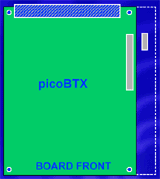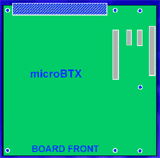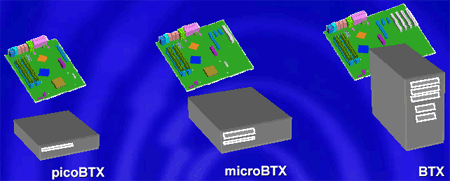Balanced Technology eXtended (BTX) Form Factor - The Future of Cases & Motherboards
by Anand Lal Shimpi on September 18, 2003 12:34 PM EST- Posted in
- Cases/Cooling/PSUs
Three different BTX sizes
Much like the multiple sizes of ATX (micro, flex, etc...), the BTX form factor allows for multiple versions of the form factor. In terms of motherboard sizes, there are three types: picoBTX, microBTX and regular BTX.
Although the board pictures below are obviously not to scale (the BTX board is clearly larger than the picoBTX board), the idea is to show you the difference in expansion slots between the boards.
 |
 |
 |
8.0" x 10.5" |
up to 10.4" x 10.5" |
up to 12.8" x 10.5" |
The picoBTX standard can support either one or two expansion slots and has four mounting holes. PicoBTX cases will probably have one 3.5" and one 5.25" drive bay.
The microBTX standard, which most are expecting to be the more popular of the three, has support for four expansion slots and has seven mounting holes. MicroBTX cases will feature one 3.5" bay and up to two 5.25" bays.

Finally we have the regular sized BTX, supporting up to a full 7 expansion slots and mounts to the case using 10 mounting screws. Regular BTX cases will be more like the mid-tower ATX cases we have today, supporting 3+ 3.5" bays and 3+ 5.25" bays.

The BTX standard allows for two case heights - Type I and Type II. Type I cases are 3.98" in height and can use normal expansion cards, while Type II cases are for small form factor designs and are 3.0" in height. Expansion cards would either use risers or be low profile in a Type II case.

The rear of a microBTX case, you can see the circular heatsink in the thermal module.










99 Comments
View All Comments
Anonymous User - Thursday, September 18, 2003 - link
This is obviously Intel getting bought off by the cae industry. If a mirror image of the btx was used instead it would be compatible with existing ATX cases, provided a front fan was installed and the screw holes lined up. I cannot imagine any other explanation for flip-flopping the motherboard other than to make it completely neccesary to buy a new box for your rig.Anonymous User - Thursday, September 18, 2003 - link
I don't understand why with the AGP slot, no manufacturer ever thought to just put the GPU and Memory on the back of the card? It's not like it wouldn't fit in 99% of the cases/MBs, and with PCI Express they could have just flipped it around, as they did when PCI came out (Compared to ISA) then you could have both PCI and PCI Express (although I don't know why that would be good), and on the same know, have AGP and 16x. Actually, this is sounding better as I think about it, is it just me? As far as moving the CPU, you don't need a new specification to do that, Intel is just making sure their new 100w CPU works ok in small cases. Go intel!!! I actually hope AMD doesn't fallow this and succeeds.Is this an Intel specification, cause I didn't here any other company's being on any press release?
Anonymous User - Thursday, September 18, 2003 - link
I hope there's a PS/2 to USB adapter for my IBM Model M =(Don't those need special controllers or something? Oh angst. Anyone?
Anonymous User - Thursday, September 18, 2003 - link
It's interesting that they propose to make the CPU the first thing to be cooled by the fresh, cool air being sucked into the chassis. This means that just about everything else will be basking in the warmth from said CPU.Of course they might figure that with a single point of entry for the air, the air flow would be so high that the air wouldn't get that hot. Some how I fear that this won't be a very good solution for high-end workstations. It is much the same idea that they used for the initial ATX standard. It didn’t take many months’ before that was silently revised. By now it's hard to find any evidence whatsoever of those early ATX specifications.
dvinnen - Thursday, September 18, 2003 - link
I'm a little torn about this. Moving the CPU was a good idea I guess. And it's finally time to get rid of Parllel, Serial, and PS/2 ports? Who actually uses parrlel or serial? But why dose it have to be incompatible with current cases? Don't make since to me. Not enough change to warrent it.Anonymous User - Thursday, September 18, 2003 - link
Don't hold your breath waiting for some thing truly useful, such as a standard for the front/case connectors. Intel had the chance with NLX, but missed it. They didn't even try touching these connectors with ATX.WTX, who cares? Its dead, and good riddance to it!
SSI, well now we are talking, but sadly no standard for the front panel connectors.
Micro ATX and Flex ATX, one of these must have had some standard for the front panel connectors? Nope!
Partly this is understandable. There are a staggering amount of motherboards, and the variation when it comes to ports, switches and LED’s are huge.
Even so I would be happy if there were a standard for the most common: Power switch, Reset switch, Power LED, HDD LED. That way you could have a working system up and running without having to either decipher microscopic markings on the MB, or digging the manual out of the round filing cabinet.
And please, for the love of what ever is holy, standardize the USB and FireWire headers. And if there still is Com ports, or a parallel port header, then make sure these also follow a common standard! Counter to popular believes, neither the headers for the serial ports, nor those for parallel ports are standardized today. Each manufacturer uses whatever pin out they fancy, and some times this is a major PITA.
jamesey - Thursday, September 18, 2003 - link
1. why cant current mobo's simply move the cpu down and near the fan.2. why cant current mobobs be designed to have a PCIX vid card fit in an ATX case?
3. This all seems uncessary.
Anonymous User - Thursday, September 18, 2003 - link
i like the way intel is legacy out the door. i doubt an avg consumer can afford an abit max just to be legacy free. but what i'm having trouble understanding is if the cpu, say a prescott w/ 100 watts of heat, is up front and getting the most cool air, won't it raise the case temp dramatically regardless, since its moving warmer air to an already hot gfx card and other components?Anonymous User - Thursday, September 18, 2003 - link
I would also like to know whether the horribly irritating job of plugging in speaker, power on switch, reset switch et al has been FINALLY eliminated by putting all the leads in a single connector. Which should have btw been done in ATX already.ChemMan - Thursday, September 18, 2003 - link
I agree, I don't see the "innovation" in all of this. It seems as though the current ATX design was mirrored and the processor moved to the front of the board. I suspect the motivation of this design was less "innovation" and more industry endorsed obsolescence in an effort to sell new parts.